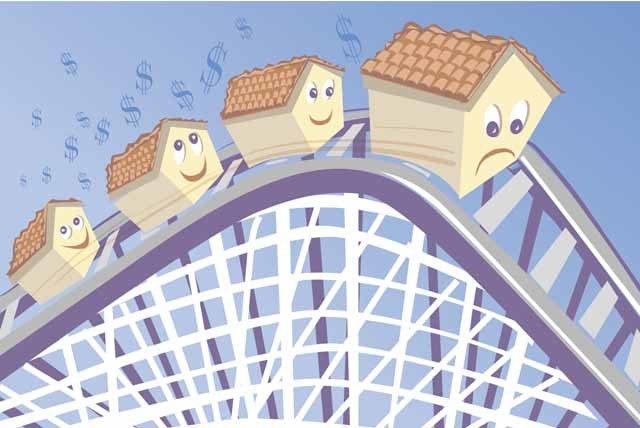Observers see long-appreciating local home values slowing
We want you to be ready.
Whether you have to sit down, stand up, pass out or go limp, we’re preparing you for the day when your home’s value doesn’t appreciate 30 percent in one year. It might seem inconceivable now, what with the double-digit annual price gains the Las Vegas market has turned in for 15 months straight, but the party’s going to end, and soon. We’ve dusted off our crystal ball to forecast exactly when, so no one can say they didn’t see it coming.
Our prediction is (drum roll): April.
It’s not that the bottom will fall out of the market, or that bubbles will burst, or that your home’s value will plummet, or that it’ll be dogs and cats, living together — mass hysteria!
It’s just simple math.
Home values across the Las Vegas Valley made huge strides from mid-2012 to mid-2013, with prices jumping by double-digit percentages year over year. But with price gains slowing this fall, 2014’s year-over-year comparisons will look smaller. When you first see the numbers this spring, they’ll look more alarming than they actually will be.
The first significant local value spike after the recession was in August 2012, when the median closing price for all housing types soared 14.5 percent year over year, to $119,000, according to figures from local housing research firm SalesTraq. Prices snowballed from there. The lowest annual appreciation was 17 percent in September 2012; the highest was 34.1 percent in April. Even in September, with increases already softening, closing prices still posted a 26.2 percent jump over the same month a year earlier.
But if you look month-to-month, price gains began slowing in summer. May’s median of $142,150 became June’s median of $151,000, for a one-month jump of 6.2 percent. The median rose 2.6 percent, to $155,000 from June to July, and went unchanged at $155,000 in August. It actually dropped a tiny bit in September, to $154,995.
Prices have evened out because investors aren’t buying nearly as much, said Brian Gordon, a SalesTraq principal. That lighter demand is putting less pressure on prices.
Plus, big price increases over the past year have left fewer people underwater, with mortgages worth more than their homes. Nov. 20 numbers from real estate website Zillow showed that fewer than 40 percent of locals have negative equity, down from more than 70 percent in 2012. That’s helping for-sale housing supplies because more people can afford to list, Gordon said.
Between lower demand and higher supply, Las Vegas has nearly three months of inventory on the market, up from about one month over the summer.
The resulting stable prices will make appreciation look comparatively anemic when 2014 rolls around. If prices stay at or near $155,000 — definitely possible given typically slow sales around the holidays and into the New Year — then April’s year-over-year growth will be about 8 percent. That would be — stay calm, now — the first single-digit-percentage appreciation rate since June 2012.
If you look at figures from the Greater Las Vegas Association of Realtors, the trends look about the same. The association’s single-family median sales price has hovered from $180,000 to $185,000 since July, ending a string of big monthly gains since August 2012, when the median was $138,000. So if prices more or less hold steady, come May the year-to-year gain will be around 9 percent. From there, experts said, expect marketwide appreciation to average a more normal 5 percent to 7 percent.
The appreciation drop is actually a good thing, observers said.
“It’s an indication that the market has recovered nearly completely from its severely depressed prices,” said Steve Brown, director of UNLV’s Center for Business and Economic Research. “The market was tremendously undervalued here, and it’s just not tremendously undervalued anymore. And it creates a situation where people buy houses based upon more normal ideas about wanting to own a home, rather than simply being driven by expectations of huge appreciation.”
Added Gordon: “This roller-coaster ride the housing market was on created havoc, not only for homeowners but for homebuilders and everyone involved in the residential real estate market. It simply wasn’t sustainable. Today’s conditions are much more reflective of a normalized housing market.”
What that normalized market means for you depends on whether you’re an owner or a buyer.
If you own, “your profit is going to level,” said Dave Tina, president of the local Realtors’ association. So no more huge annual returns on your real estate. That’s really only a problem if you bought at the peak, in 2006 or 2007, and you still owe more than your home is worth. If that’s your case, you shouldn’t anticipate gaining much more ground on your negative equity in the near term unless you can pay down your loan faster, Brown said.
For buyers, today’s market should bring welcome relief. No more tacking $10,000 onto a list price because that’s how much more the value will have jumped in a month, when the appraisal comes through, Tina said. There’ll also be a lot less competition against “hot-money investors” for scarce listings, Brown said. And with that will come a more “normal” mix of buyers, including mortgage-backed owner-occupiers, he said.
Gordon said he sees potential for “modest price declines” as supply increases, particularly if homes in foreclosure begin to come onto the market in larger numbers.
To prevent a supply glut, banks are likely to feed repossessed properties onto the market relatively slowly, Tina said. Regardless, the three agreed the city’s housing depression is pretty much over for good.
“Nobody expects to see the free-fall in prices that the market experienced in this past economic downturn,” Gordon said.
Contact reporter Jennifer Robison at jrobison@reviewjournal.com. Follow @J_Robison1 on Twitter.






















